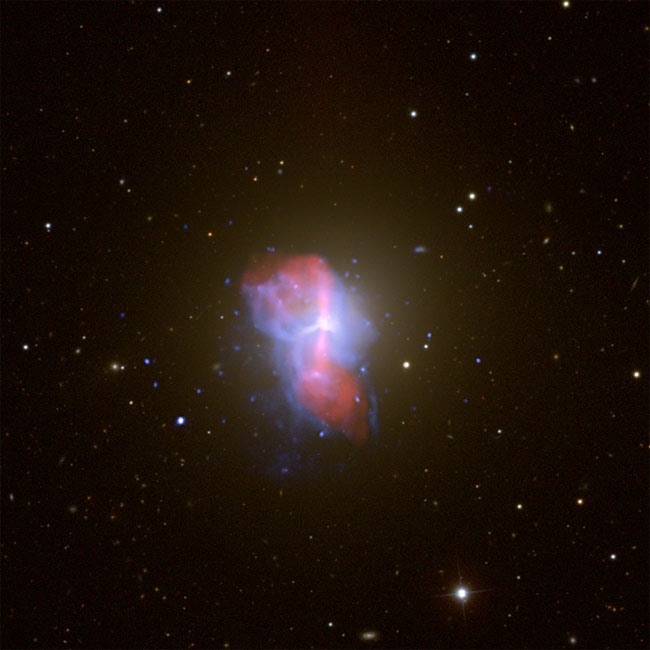[/caption]
Apparently, black holes can walk and chew gum at the same time. Or at least they can chew up gas and dust and blow supersonic bubbles with it at the same time. Analysis into the formation of large bubbles of plasma formed by supermassive black holes reveals that creating the bubbles may stunt the growth of the black hole, as well as curb star formation in elliptical galaxies.
Many galaxies (including our own Milky Way) contain a black hole at the center, which constantly sucks in material from the surrounding regions. As the material gets close to the black hole, it bunches up, jostling with other material being sucked into the black hole and giving off energy. This process powers quasars – jets of radio and light emissions beamed into space.
A team of international astronomers imaged the elliptical galaxy M84 using the Chandra X-ray observatory. M84 has just such a black hole, and at the ends of each of its jets large cavities of ionized gas (plasma) form. The bubbles measure 13,000 light years across, and are formed about every 10 million years.
The constant cycle of bubbles being blown inside of each other, then “popping” and releasing their energy to the may slow the stream of matter that flows into the black hole.
As the outer bubble leaks its energy into the surrounding interstellar medium and disperses, the next bubble expands to take its place. Colder matter surrounding a black hole (outside the event horizon) is absorbed more readily than warmer matter. In the same way that heat rises in your house, hot gas surrounding the black hole is harder for it to capture, so the bubbles slow the growth of the black hole by siphoning off the matter and energy it could potentially feed on.

.
And as if bubbles of plasma 13,000 light years across surrounding a black hole weren’t impressive enough, the transfer of thermal energy into mechanical energy creates shock waves traveling at hypersonic speeds that expand the bubbles. Try getting your standard bubble blowing apparatus to do that!
The transfer of energy into the gas contained in an elliptical galaxy could potentially limit the amount of star formation there, in addition to stunting the growth of the supermassive black hole. Stars form out of the dust and gas in the interstellar medium, and the hotter the gas and dust is, the less likely it is to clump up due to gravitational interaction with surrounding material and snowball enough to create a star.
The results are be published in the Oct. 20th issue of the Astrophysical Journal, and the pre-print article can be found on Arxiv.
Source: Space.com


Nom nom nom
mmm, shock waves in vacuum?
plasma waves dont create shockwaves in vacuum.
just to clarify.
Strange that it’s always the same assumption, although the visible dust is always blowing AWAY from the black hole at the poles.
And as always the dust falling into the black-hole is invisible, but must be there to the “experts”.
Is there any logic behind this? No and yes.
All the evidence is pointing to the black hole itself as the source and not to this terrible intellectual construction of a an “accretion disc”.
The whole idea of accretion of matter at the poles of a black hole is born out of scientific prejudice because of existing lack of knowledge and understanding in my opinion.
Someone mind explaining to me how a black whole can ‘burp’ out plasma bubbles when it is supposed to suck in everything, even light?
Isn’t this contradictory?
And I have been always wondering why the black holes would not end up by simply “eating” everything around them, including each other (like those rats in a cage feeding on each other). It would be quite naturally to expect that after the last two really mighty fat winners would swallow each other, then – BANG! – it all will start a new.
This perspective looks much more convincing in my view than that huge infinitively expanding universe and all this staff about red doppler shift of the wave length. In the light of the recent discoveries regarding back matter and black energy, did nobody so far come to revise the theory of the expanding Universe?
An idea of contracting Universe is appealing to a common person’s mind also because it provides a very simple and non-sophisticated answer as to how it all started…